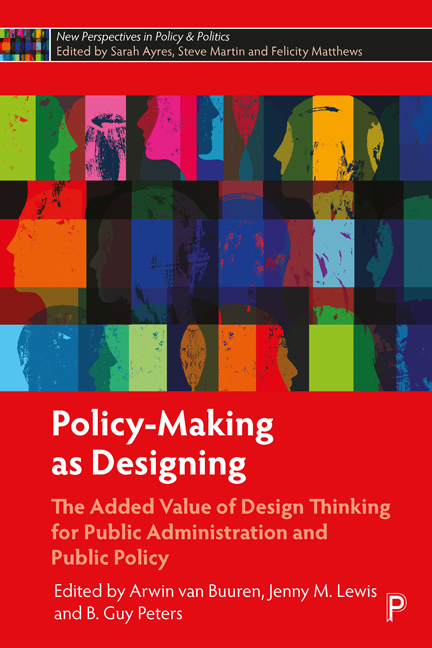 Policy-Making as Designing
Policy-Making as Designing Book contents
- Frontmatter
- Contents
- List of figures and tables
- Notes on contributors
- 1 Improving public policy and administration: exploring the potential of design
- 2 Applying design in public administration: a literature review to explore the state of the art
- 3 Challenges in applying design thinking to public policy: dealing with the varieties of policy formulation and their vicissitudes
- 4 Designing environments for experimentation, learning and innovation in public policy and governance
- 5 Policy Labs: the next frontier of policy design and evaluation?
- 6 When design meets power: design thinking, public sector innovation and the politics of policy-making
- 7 Designing institutions for designing policy
- 8 Applying design science in public policy and administration research
- 9 Using a design approach to create collaborative governance
- 10 Policy-making as designing: taking stock and looking forward
- Index
1 - Improving public policy and administration: exploring the potential of design
Published online by Cambridge University Press: 20 January 2024
- Frontmatter
- Contents
- List of figures and tables
- Notes on contributors
- 1 Improving public policy and administration: exploring the potential of design
- 2 Applying design in public administration: a literature review to explore the state of the art
- 3 Challenges in applying design thinking to public policy: dealing with the varieties of policy formulation and their vicissitudes
- 4 Designing environments for experimentation, learning and innovation in public policy and governance
- 5 Policy Labs: the next frontier of policy design and evaluation?
- 6 When design meets power: design thinking, public sector innovation and the politics of policy-making
- 7 Designing institutions for designing policy
- 8 Applying design science in public policy and administration research
- 9 Using a design approach to create collaborative governance
- 10 Policy-making as designing: taking stock and looking forward
- Index
Summary
Introduction
Governments see themselves as increasingly confronted with complex or wicked problems (such as climate change and migration). Characteristic for such issues is that many different stakeholders are involved, with different ambitions, interests and perceptions. A solution for one actor may imply an increase in problems for others (Head, 2008). At the same time, citizens’ expectations of public services have increased (Armstrong et al, 2014; Kimbell, 2016; Bailey and Lloyd, 2017; Bason, 2017). In this context, design approaches are seen as a promising way to provide smarter and more agile ways to empathise with these actors and their problems, and to find mutually beneficial opportunities and solutions (Armstrong et al, 2014; Bason, 2016; Mintrom and Luetjens, 2016).
At the same time, thinking about design for public issues is far from new. Some 50 years ago, Herbert Simon already called public administration (PA) a design science. That implies, in the view of Simon, that this field is different from the natural sciences since it studies the artificial – or human made – instead of the natural and, as such, deals with the contingent instead of the necessary – with how things might be instead of with how things are. Design ‘is concerned with how things ought to be, with devising artefacts to attain goals’ (Simon, 1969: 133). In Simon's view, the core of designing is the ability to deal with situations as one encounters them by both diagnosing the problem and devising a way to deal with it. Whether that solution is the design of a material artefact, a treatment plan for a sick patient or a social welfare policy does not really matter. The idea of PA as a design science has since then been underlined by several scholars in the field (for example, Shangraw and Crow, 1989; Frederickson, 2000; Meier, 2005; Walker, 2011).
However, it seems that the current attention on design and design methods aligns with a different approach to Simon’s. Recent applications of design methods involve the use of design or policy labs, design charrettes and other experimental and exploratory approaches.
- Type
- Chapter
- Information
- Policy-Making as DesigningThe Added Value of Design Thinking for Public Administration and Public Policy, pp. 1 - 17Publisher: Bristol University PressPrint publication year: 2023


